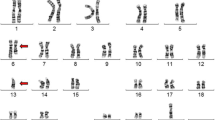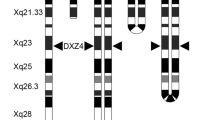Summary
X-inactivation patterns were studied by replication analyses both in lymphocytes and skin fibroblasts of two patients carrying balanced X-autosome translocations, t(X;10)-(pter;q11) and t(X;17)(q11;q11), and one patient with an unbalanced translocation t(X;22)(p21;q11). Preferential late replication of the normal X chromosome was found in lymphocytes of both patients carrying balanced translocations and in skin fibroblasts of the patient carrying the translocation t(X;17). However, skin fibroblasts of the patient with a translocation t(X;10) showed preferential late replication of the abnormal der(X) chromosome with no spreading of late replication to the autosomal segment. In the case of unbalanced translocation t(X;22) there was preferential late replication of the der(X) chromosome both in lymphocytes and skin fibroblasts. The abnormal phenotype of the patients is discussed in relation to the observed X-inactivation patterns and the variability of the patterns in different tissues.
Similar content being viewed by others
References
Allen JW, Latt SA (1976) In vivo BrdU-33258 Hoechst analysis of DNA replication kinetics and sister chromatid exchange formations in mouse somatic and meiotic cells. Chromosoma 58:325–340
Carpenter N, Say B, Browning D (1980) Gonadal dysgenesis in a patient with an X;3 translocation: Case report and review. J Med Genet 17:216–221
Cohen M, Ratazzi MC (1971) Cytological and biochemical correlation of late X-chromosome replication and gene inactivation in the male. Proc Natl Acad Sci USA 68:544–548
Couturier J, Dutrillaux B, Garber P, Raoul O, Croquette MF, Fourlinnie JC, Maillard E (1979) Evidence for a correlation between late replication and autosomal gene inactivation in a familial translocation t(X;21). Hum Genet 49:319–326
de la Chapelle A, Herva R, Koivisto M, Aula P (1981) A deletion in chromosome 22 can cause DiGeorge syndrome. Hum Genet 57:253–256
Disteche CM, Eicher EM, Latt SA (1979) Late replication in an X-autosome translocation in the mouse; correlation with genetic inactivation and evidence for selective effects during embryogenesis. Proc Natl Acad Sci USA 76:5234–5238
Eicher EM (1970) X-autosome translocations in the mouse: Total inactivation versus partial inactivation of the X chromosome. Adv Genet 15:175–259
Epstein CJ, Smith S, Travis B, Tucker G (1978) Both X chromosomes function before visible X-chromosome inactivation in female mouse embryos. Nature 276:500–503
Gartler SM, Andina RJ (1976) Mammalian X-chromosome inactivation. Adv Hum Genet 7:99–140
Gartler SM, Linder D (1964)Selection in mammalian mosaic cell populations. Cold Spring Harbor Symp Quant Biol 29:253–260
Hamerton JL, Richardson BJ, Gee PA, Allen WR, Sort RV (1971) Non-random X chromosome expression in female mules and hinnies. Nature 232:312–319
Hellkuhl B, de la Chapelle A, Grzeschik K-H (1982) Different patterns of X chromosome inactivity in lymphocytes and fibroblasts of a human balanced X: autosome translocation. Hum Genet 60:126–129
Jacobs PA (1974) Correlation between euploid structural chromosome rearrangements and mental subnormality in humans. Nature 249:164–165
Jacobs PA, Matsuura JS, Mayer M, Newlands IM (1978) A cytogenetic survey of an institution for the mentally retarded: I. Chromosome abnormalities. Clin Genet 13:37–60
Jacobs PA, Hunt PA, Mayer M, Bart RD (1981) Duchenne muscular dystrophy (DMD) in a female with an X/autosomal translocation: Further evidence that the DMD locus is at Xp21. Am J Hum Genet 33:513–518
Kelley RI, Zackai EH, Emanuel BS, Kistenmacher M, Greenberg F, Punnett HH (1982) The association of the DiGeorge anomalad with partial monosomy of chromosome 22. J Pediatr 10:197–200
Kratzer PG, Gartler SM (1978) HGPRT activity changes in preimplantation mouse embryos. Nature 274:503–504
Latt SA (1973) Microfluorometric detection of deoxyribonucleic acid replication in human metaphase chromosomes. Proc Natl Acad Sci USA 70:3395–3399
Latt SA, Stetten G, Juergens LA, Willard HF, Sher CD (1975) Recent developments in the detection of deoxyribonucleic acid synthesis by 33258 Hoechst fluorescence. J Histochem Cytochem 23:493–505
Lyon MF (1961) Gene action of the X chromosome of the mouse (Mus musculus L.). Nature 190:372–373
Madan K, Hompes PGA, Schoemaker J, Ford CE (1981) X-autosome translocations with a breakpoint in Xq22 in a fertile woman and her 47,XXX infertile daughter. Hum Genet 59:290–296
Mameli M, Cardia S, Mila A, Seabright M (1978) A further case of a 22:22 Robertsonian translocation associated with recurrent abortions. Hum Genet 211:359–361
Mattei MG, Mattei JF, Ayme S, Malpuech G, Giraud F (1978) A dynamic study in two new cases of X chromosome translocation. Hum Genet 41:251–257
Mattei MG, Mattei JF, Ayme S, Giraud F (1982) X-autosome translocations: cytogenetic characteristics and their consequences. Hum Genet 61:295–309
McMahon A, Monk M (1983) X-chromosome activity in female mouse embryos heterozygous for Pgk-1 and Searle's translocation, T(X;16)16H. Genet Res Camb 41:69–83
Migeon BR, Shapiro LJ, Norum RA, Mohandas T, Axelman J, Datora RL (1982) Differential expression of steroid sulfatase locus on active and inactive human X chromosomes. Nature 299:838–840
Mohandas T, Crandall BF, Sparkes RS, Passage MB, Sparkes MC (1981) Late replication studies in a human X/13 translocation: Correlation with autosomal gene expression. Cytogenet Cell Genet 29:215–220
Mohandas T, Sparkes PS, Shapiro LJ (1982) Genetic evidence for the inactivation of a human autosomal locus attached to an inactive X chromosome. Am J Hum Genet 34:811–817
Nakagome Y (1982) Inactivation centers in the human X chromosome. Am J Hum Genet 34:182–194
Ohno S, Cattanach BM (1962) Cytological study of an X-autosome translocation in the Mus musculus. Cytogenetics I:129–140
Richards BW (1969) Mosaic mongolism. J Ment Defic Res 13:66–83
Russell LB (1961) Genetics of mammalian sex chromosomes. Science 133:1795–1803
Sands M (1980) Mental redardation in association with a balanced X-autosome translocation and random inactivation of the X chromosome. Clin Genet 17:309–316
Shapiro LJ, Mohandas T, Weiss R, Romeo G (1979) Non-inactivation of an X-chromosome locus in man. Science 204:1224–1226
Summit RL, Tipton RE, Wilroy RS, Martens PR, Phelan JP (1978) X autosome translocation: A review. Birth Defects 14:219–247
Thelen TH, Abrams DJ, Fisch RO (1971) Multiple abnormalities due to possible genetic inactivation in an X/autosome translocation. Am J Hum Genet 23:410–418
Therman E, Denniston C, Sarto GE, Ulber M (1980) X chromosome constitution and the human female karyotype. Hum Genet 54:133–143
Wilson MG, Towner JW, Forsman I (1980) Decreasing mosaicism in Down's syndrome. Clin Genet 17:335–340
Author information
Authors and Affiliations
Rights and permissions
About this article
Cite this article
Disteche, C.M., Swisshelm, K., Forbes, S. et al. X-inactivation patterns in lymphocytes and skin fibroblasts of three cases of X-autosome translocations with abnormal phenotypes. Hum Genet 66, 71–76 (1984). https://doi.org/10.1007/BF00275190
Received:
Revised:
Issue Date:
DOI: https://doi.org/10.1007/BF00275190




